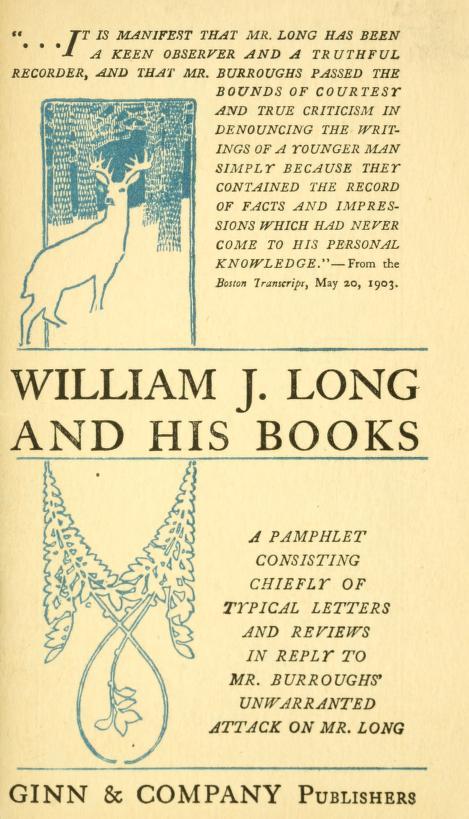This post is part of a series on the collection of ornithologist William Brewster (1851-1919) at the Ernst Mayr Library, written by Elizabeth Meyer, library project assistant.
A 1907 journal entry finds Brewster weighing in on the ‘nature fakers’ controversy which had nature writers sparring. As he explains the situation:
... there are popular writers, widely read and apparently very generally credited, who assert that it has been their frequent experience, when camping in the remote parts of Northern New England or of eastern Canada, to meet with … [animals] and to see them do all manner of strange and wonderful things. Some of their accounts of the habits and especially of the reasoning powers of these ... animals are so grossly absurd and improbable that they are not likely to do any considerable or at least permanent harm. Indeed they may safely be left to discredit themselves for this they will surely do, sooner or later. [1]
In 1903, naturalist-writer John Burroughs (a colleague and correspondent of Brewster’s) had written an inflammatory article entitled “Real and Sham Natural History” for The Atlantic Monthly, in which he had particularly criticized writers William J. Long (“School of the Woods”) and to a lesser extent Ernest Thompson Seton (“Wild Animals I have Known”). [2] Later, President Roosevelt supported this criticism by giving an interview on “Nature Fakirs” for Everybody’s Magazine in 1907. [3]
Burroughs wrote about “the danger that is always lurking near the essay-naturalist […] the danger of making too much of what we see and describe, - of putting in too much sentiment, too much literature, - in short, valuing these things for the literary effects we can get out of them.” [2] In other words, the distinctions between popular literature and zoological work were blurry, and scientific naturalists felt that the credibility of their field was being undermined.

Cover of ‘William J. Long and his books : a pamphlet consisting chiefly of typical letters and reviews in reply to Mr. Burroughs' unwarranted attack on Mr. Long.’ Boston: Ginn & Company Publishers, [1903] Available on BHL.
As a member of the naturalist-writer circle, Brewster contemplates the issue in his journal:
The misrepresentation on the part of such writers ... is more dangerous and pernicious because, like most false coloring, it is too vague and subtle, and also too nearly possible, to be easily analyzed and convincingly exposed. Whenever their statements are publicly questioned these "Natures fakers", as they have come to be called, defend themselves rather plausibly and effectively by insisting that evidence or opinion contrary to their own is of necessity, negative in character and hence of little weight. Because others have not seen this or that is no good reason, they assert, for doubting that is has occurred or may exist. [1]
He continues,
If he [critiquer] be a sportsman or a collector they [‘Nature Fakers’] delight to picture him as a bloodthirsty being habitually carrying a gun in his hands and the lust of killing in his heart. If he would become really familiar with the wood folk and their ways let him go among them unarmed and in a spirit of peace and loving kindness towards them all. Then he will learn many things which the bearers of guns do not know and cannot be made to believe. [1]
Judging by the tone, it seems that these criticisms hit some of the nature-loving specimen collector’s nerves. (See a previous blog post about Brewster’s evolving opinions on scientific collecting and nature conservation.)
However, his indignance shifts to a defense of Ernest Thompson Seton, a friend whom he felt had been unfairly classed as a fake naturalist.
Even when [Seton’s] imagination leads him into realms of which neither he nor any other man can have definite knowledge it seldom or never betrays him into using false coloring. He is too good an artist and by far too well trained a naturalist to fall into any such error. Yet he has been classed with the ‘nature fakers’ by some of his critics. ... I believe the best of his essays will be regarded as classics long after the now popular writings of certain of his contemporaries and imitators will have quite ceased to be read or even remembered. [1]
He also suggests that the romanticized nature stories did have some merits.
It must be admitted that the ‘nature fakers’ have atoned, at least in part, for the harm which they have done by interesting very many people - who probably could not have been reached in other and less sensational ways - in the study of nature. In their estimate of animal intelligence, too, they have, I think, come nearer the truth - despite their frequent exaggeration or distortion of it - than have such of their critics as are disposed to deny that any animal except man can possess reasoning powers. [1]
[1] August 1907. Journals of William Brewster, 1871-1919 (inclusive). 1907.
[2] Atlantic Monthly, v. 91. 1903. “Real and Sham Natural History”. John Burroughs. Web accessed on Google Books.
[3] Everybody’s Magazine, v. 16. No. 6. 1907. “Roosevelt on the Nature Fakirs”. Edward B. Clark. Web accessed on Google Books.

